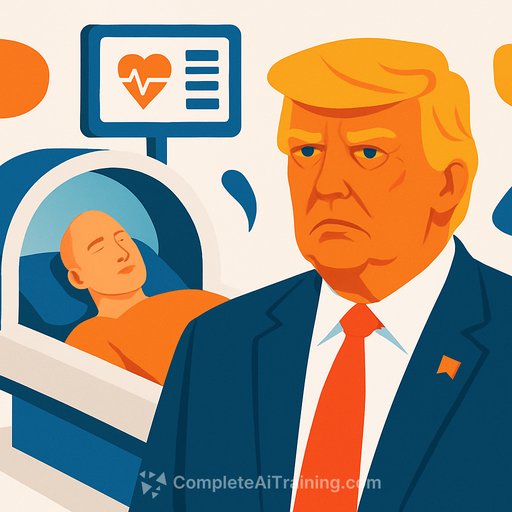News: Trump Shares AI-Generated Fake Video Promoting Fictional "Medbed" Technology
Over the weekend, Donald Trump shared a video that appeared to be generated with AI. The clip mimicked a Fox News segment and showed a synthetic version of the former president promoting a "medbed" program as a universal cure. It was later identified as fabricated and removed. Major outlets reported on the video's spread and the claims attached to it.
What the fake video claimed
The fake message promised nationwide access to "medbeds" as a new standard of care. It included lines such as, "Every American will soon be issued their own medbed card," and described facilities "designed to restore every citizen's full health and strength." The framing suggested a sweeping overhaul of U.S. healthcare backed by secret technology.
Why "medbed" myths persist
The "medbed" idea grew in online conspiracy spaces, including QAnon communities, where hidden cures and reverse-engineered alien technology are recurring themes. The narrative taps into distrust of institutions and the belief that life-saving solutions are being withheld. These claims often reappear alongside UFO speculation and government secrecy tropes.
Why this matters for government and healthcare leaders
AI-generated political content can erode trust, drive false hope, and trigger real-world behavior-especially when it targets health services. Public agencies, health systems, and insurers may face pressure from patients, constituents, and staff who encounter persuasive fabrications. Clear protocols for verification, response, and public guidance are now an operational necessity.
How to detect and counter such manipulations
- Verify the source: Check the original publisher, official channels, and site domains. Be wary of clips without clear provenance or those posted by accounts with recent creation dates.
- Inspect the context: Compare the video to known appearances, schedules, and prior statements. Mismatches in lighting, lip-sync, framing, or overlays are common red flags.
- Cross-check with independent coverage: Seek confirmation from multiple reputable outlets before sharing or responding. One unverified post should not drive policy or communications decisions.
- Confirm authenticity with provenance tools: Favor content carrying authenticated media credentials, such as content credentials standards from the C2PA.
- Time-stamp and archive: Record when and where you found the content. Preserve URLs and files for internal review, legal, or public affairs teams.
- Establish an escalation path: Route suspect media to your communications lead, security team, and legal for coordinated action and public guidance.
- Issue clear public updates: If your organization is named or implicated, publish a brief, factual statement on official channels. Avoid repeating false details-state what is false and where to find accurate information.
- Educate frontline staff: Train schedulers, call centers, clinicians, and constituent services to handle inquiries about "miracle" treatments with consistent scripts and referral links.
- Coordinate with partners: Align with state health departments, hospital associations, insurers, and emergency management on unified messaging to reduce confusion.
- Reinforce media literacy: Share reputable guidance on health misinformation with communities and staff. The U.S. Surgeon General's advisory on health misinformation is a useful reference point (HHS).
Operational steps you can take this week
- Publish a short internal memo defining deepfakes and your verification workflow.
- Set a 24/7 point of contact for media authentication requests.
- Create pre-approved response templates for "fake video" and "false cure" claims.
- Add authenticity checks (source, date, C2PA, reverse image search) to your social media SOP.
- Brief leadership so they can answer questions without amplifying false claims.
The bottom line
AI makes convincing forgeries easy to produce and fast to spread. Government and healthcare organizations need rapid verification, coordinated messaging, and staff training to keep the public anchored to facts. Treat sensational "cure-all" content as unverified until proven otherwise.
If your team needs structured resources to upskill on AI literacy and content verification, see our curated training options for different roles: AI courses by job.
Your membership also unlocks:










